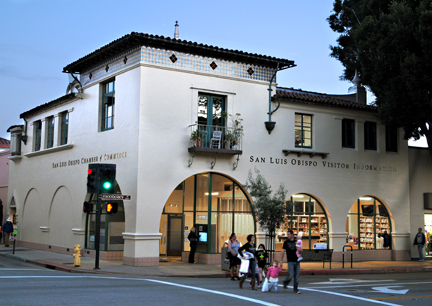Roughly midway between San Francisco and Los Angeles on California’s magnificent coast sits San Luis Obispo, a town as unassuming as it is picturesque.
Nestled among golden oak-studded hills, the peaceful, little community is home to Mission San Luis Obispo de Tolosa (one of 21 up and down the state) as well as the prestigious California Polytechnic State University (Cal Poly), consistently ranked by U.S. News and World Report as one of this nation’s top-rated universities. San Luis Obispo (affectionately known as SLO Town or simply going by SLO, for short) is as well a leader when it comes to matters of environmental sustainability. And one of the area’s going concerns, the San Luis Obispo Chamber of Commerce, has just recently jumped on that same bandwagon.

“This has been a great way to implement the sustainable values held by our business community and has allowed us to educate and lead the way for other businesses to use these solutions in their own businesses,” Biddinger expressed in an email.1 “We have over 75,000 people come through our doors every year to learn more about San Luis Obispo, and our new building is a strong expression of our community’s values and priorities.”
In that a seismic retrofit of the Chamber’s former offices prompted the move to the current site and given the Chamber Board of Directors have always been staunch environmental-sustainability advocates, it followed then that the “new offices would be designed/built to support these values,” Biddinger wrote.
The Chamber building upgrade reflects the Chamber’s commitment toward reduced energy usage, in its support of the environment and last but by no means least, in “showcasing cost-effective green business practices.”
Biddinger provided several examples. These are:
80% of construction materials diverted from landfill: By reusing and recycling materials we helped divert 80 percent of our construction waste, including wood scraps, metal and concrete from local landfills, drastically minimizing our impact. Forty-five percent of existing walls and framing were reused, keeping even more material out of the waste stream.
Optimized energy performance: Our commitment to using renewable and sustainable energy included a high-efficiency ventilation system, LED lighting that is 33 percent more efficient and a long-term commitment to purchase energy from renewable sources. More than 80 percent of new equipment and appliances are Energy Star rated.
Re-used and recycled local furnishings: Forty percent of all new furniture is regionally manufactured and created from recycled materials. All new windows, doors, door frames, gypsum, metal stud framing, signage, sun tubes and the boardroom table are manufactured within 500 miles. The Visitor Center countertops are 100 percent recycled content, and the storefront windows include 46 percent recycled content.
Daylighting: maximizing natural light: Interior windows and skylights provide daylight in most work spaces. Photo sensors shut off electric lights near skylights and windows when daylight is sufficient.
Water Reduction: All new appliances were specifically selected for their efficiency in water conservation. Low-flow toilets and aerating restricted water faucets reduce our water consumption by 23 percent.
Where energy savings are concerned, since completion of the remodeling, there has been an estimated 30 percent cost savings. What’s more, with the more energy efficient building, neither comfort, nor convenience, nor the beautiful building design aesthetic has been sacrificed in any way, shape or form – a testament to the work done.
Added Biddinger: “While all the upgrades have been great improvements, the most prominent and commented on feature is the building’s natural light. The light that streams through the windows and skylights has not only reduced the energy lighting needs, they have added a great feeling of spaciousness and beauty.”
For other such enterprises considering similar upgrading, the SLO Chamber of Commerce interim marketing director has the following advice:
“While there are costs associated with any move or building upgrade (and most Chamber’s tend to run on tight budgets), we encourage any Chamber that has the ability, to take the lead in showing the community the importance of building sustainable environments.”
She also suggests those in the community having similar values partner with their chambers of commerce to help in support of such efforts.
“It is a win-win partnership with the Chamber giving its business members a permanent showcase for their support,” Biddinger insisted.
For more information on the SLO Chamber of Commerce, go here.
Notes
- Lynne Biddinger, Interim Director of Marketing, San Luis Obispo Chamber of Commerce, San Luis Obispo, California, personal communication, May 28, 2014.
Image above: Courtesy of Lynne Biddinger, San Luis Obispo Chamber of Commerce
This post was last revised on Jun. 21, 2020 @ 7:42 a.m. Pacific Daylight Time.
– Alan Kandel
